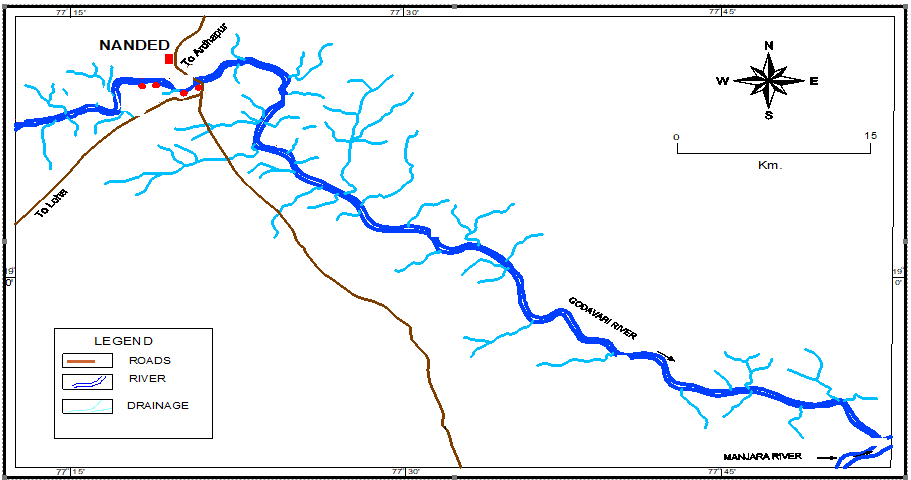Ijraset Journal For Research in Applied Science and Engineering Technology
- Home / Ijraset
- On This Page
- Abstract
- Introduction
- Conclusion
- References
- Copyright
Uses of Urban Sewer Water for Agriculture in Nanded City, Maharashtra, India
Authors: Pawale R. G., Yannawar V. B.
DOI Link: https://doi.org/10.22214/ijraset.2024.65053
Certificate: View Certificate
Abstract
Estimating the effluent\'s quality is crucial for much wastewater research, as wastewater\'s chemical and physical characteristics influence its amount and usability. Field observations regarding the source or circumstances of wastewater occurring, the source of pollution, and other relevant factors that may impact wastewater quality are considered when assessing wastewater quality. The sustainability of wastewater for use is evaluated based on factors including pH, EC, TDS, hardness, total alkalinity, chloride, nitrate, sodium, and potassium. The assessment of sewer sustainability for irrigation is contingent upon its electrical conductivity and sodium content. These investigations were conducted in 2022 and 2023. Water samples gathered from industrial effluent, primarily used in farmlands and solely in the nearby areas, were examined in this study.
Introduction
I. INTRODUCTION
Population growth, urbanization, improved living standards, and economic development have led to increased volumes of wastewater across domestic, industrial, and commercial sectors (Asano et al., 2007; Lazarova & Bahri, 2005). According to the United Nations World Water Development Report, industry accounts for 22% of global water withdrawals, varying from 59% in high-income countries to 8% in low-income countries. In contrast, agriculture uses approximately 50% of freshwater (Brenda & Lee, 2009). In India, only 24% of the wastewater produced by households and industries is treated before being used for agriculture or discharged into rivers (Minhas & Samra, 2003). Although many sewage treatment plants manage some wastewater, they often need proper operation and maintenance. Globally, up to two-thirds of sewage is untreated, with fewer than 10% of existing treatment plants in Mexico operating satisfactorily (Mario & Boland, 1999). One environmental concern associated with wastewater use is groundwater contamination, which can lead to high concentrations of nitrates, salts, and microorganisms (USEPA, 1992).
Salinity from wastewater can hinder crop productivity by suppressing growth during the pre-seedling stage, causing nutritional imbalances, and introducing toxic ions (Kijne et al., 1998). Farmers growing exotic vegetables for the market, which they do not consume, might need to be aware of potential health risks associated with their practices (Drechsel et al., 2006). High nitrogen levels in wastewater can lead to nitrate contamination of groundwater sources used for drinking, posing health risks. Additionally, the accumulation of heavy metals in soils and their uptake by plants present significant risks with wastewater irrigation (Khouri et al., 1994). The improper disposal of domestic and industrial wastes, whether through land accumulation or river discharge, can lead to severe ecological issues (Eckenfelder, 2000). Wastewater often contains heavy metals, toxic chemicals, chlorides, and other pollutants, exacerbating these problems (Uberai, 2003).
In developing countries such as China, Mexico, Peru, Egypt, Lebanon, Morocco, India, and Vietnam, wastewater has long been a nutrient source for crops (AATSE, 2004; Jimenez & Asano, 2008). Using untreated wastewater for agriculture has been used for centuries (Keraita et al., 2008). Estimates suggest that over 4–6 million hectares of land are irrigated with wastewater or polluted water (Jimenez & Asano, 2008; Keraita et al., 2008; UNHSP, 2008), with some estimates reaching 20 million hectares, nearly 7% of the world's irrigated land (WHO, 2006). A review integrating data from Jiménez and Asano (2008) and UNHSP (2008) indicates that 46 countries use polluted water for irrigation. In West Africa, 50 to 90% of vegetables consumed in urban areas are grown locally with contaminated irrigation water (Drechsel et al., 2006). In Pakistan, about 26% of national vegetable production relies on wastewater for irrigation (Ensink et al., 2004).
This study aims to analyze and assess the suitability of industrial wastewater for agricultural practices, specifically for crop irrigation, in and around Nanded City.
II. MATERIALS AND METHODS
2.1 Study Area: Nanded is situated between 18°15' and 19°55' North latitude and 77°07' to 78°15' East longitude. The district spans a geographical area of 10,528 square kilometers. As one of Maharashtra's fastest-growing cities in the Marathwada region, Nanded has experienced significant development (Yannawar et al., 2013; Yannawar, 2015).

Fig.2.1: Showing selected sampling locations in the Godavari River of Nanded City, Maharashtra
2.2 Site and Field Selection: Two and three fields were chosen for monitoring irrigation practices, nutrient applications, and heavy metal accumulation. The wastewater from the oil and cattle feed industries is utilized in agricultural areas near Vasarni, Nanded. Central sewage has been supplied for over thirty years from the cattle feed industries in the Maharashtra Industrial Development Corporation (MIDC) and the City and Industrial Development Corporation (CIDCO) of New Nanded.
2.3 Sampling Methods: The effluent samples for this investigation were collected from local cattle feed industries in Nanded's MIDC. Physical and chemical parameters were analyzed following the Standard Methods for Examining Water and Wastewater, 17th edition, APHA (1998). Sampling was conducted three times each morning from 2022 to 2023. pH, temperature, dissolved oxygen, and total dissolved solids were measured immediately, while other parameters were analyzed later in the laboratory using standard methods. This descriptive cross-sectional study involved sampling raw urban wastewater from orchards and farms during the spring and summer months (May to August). The aim was to assess critical parameters relevant to crop irrigation in these areas. Sampling was carried out according to established standard methods.
III. RESULTS AND DISCUSSION
This study examined water samples from industrial wastewater collected between 2022 and 2023. Various physical parameters were measured, including total solids, total dissolved solids, electrical conductivity, and color. Additionally, estimated chemical parameters such as pH, carbon dioxide, total hardness, phenolphthalein alkalinity, total alkalinity, salinity, total acidity, oil, and grease were assessed. Ionic parameters, including chloride, phosphate, sulfate, calcium, magnesium, sodium, potassium, fluoride, iron, chromium, and manganese, were also analyzed. Biological properties such as the standard plate count and most probable count were determined. Color is typically the first noticeable contaminant in wastewater and impacts water bodies' aesthetics, transparency, and gas solubility (Yuxing & Jian, 1999). All discharge samples exhibited a blackish hue. The pH of the wastewater ranged from 6.9 to 8.7, with temperatures varying from 20°C to 30°C. Total dissolved solids ranged from 784 to 1730 µM, reflecting the water's varied dissolved and suspended component concentrations.
The data from this study revealed significant variations in water quality based on physicochemical properties. The accompanying graphs detail and illustrate average values for various wastewater quality parameters. This report highlights the strong relationship between wastewater use and management practices.
For farmers in this semi-arid region, a consistent wastewater supply is crucial for cultivating high-value vegetables and crops. The availability of wastewater continues throughout the year, allowing farmers to rotate its use and exchange resources to match crop water needs better. During dry periods or at the end of irrigation systems, wastewater may be the only available water source in regions like Haroonabad, Pakistan, and Hyderabad, India (Ensink et al., 2004; Ensink, 2006). All parameters, except electrical conductivity (EC) and pH, are reported in mg/L. These values are compared against limits for industrial effluent discharged into inland surface waters. Farmers often experiment to address production risks like pest infestations, water shortages, or diminishing availability of fertile land and labor (Mutsaers et al., 1997). While health risks are not a significant concern due to low awareness, poor water quality can still be problematic for farmers, even if its health impacts are not immediately recognized. Therefore, it is crucial to encourage farmers to seek their solutions, as several home remedies can unintentionally mitigate health risks (IWMI, 2008).
Conclusion
There is room for improvement in water and nutrients in Nanded, where there is a lack of industrial pollution, impoverished farmers use untreated water, and the economic benefits of wastewater use are maximized. Adequate controls should be put in place at the same time to manage different illnesses in populations that are exposed to wastewater. It is concluded that all of the norms specified by the Ministry of Environment Forest, New Delhi, and the Standards of Environmental Protection Act apply to the effluent discharged from the oil and cattle feed industry and adjacent industries, except oil and grease. Thus, environmental disposal should receive less consideration. Farmers and scientists need to identify areas of agreement and apply information to alter attitudes and actions. When improperly supervised, wastewater utilization presents severe health and environmental dangers to agriculture crops and human health.
References
[1] APHA, 1998, Standard Methods for Examining Water and Wastewater. American Public Health Association, 20th edition, Washington. D.C. [2] Asano, T., Burton, F. L., Leverenz, H., Tsuchihashi, R. and Tchobanoglous, G. (2007) Water Reuse: Issues, Technologies, and Applications, McGraw-Hill, New York. [3] Drechsel, P. S., Graefe, M., Sonou, O. and Cofie, O. (2006) Informal Irrigation in Urban West Africa: An Overview, Research Report 102, IWMI, Colombo, [4] Eckenfelder, W. W. (2000) Industrial water pollution control. Boston: McGraw-Hill. [5] Ensink, J. (2006) ‘Water quality and the risk of hookworm infection in Pakistani and Indian sewage farmers’, PhD thesis, London School of Hygiene and Tropical Medicine, University of London, London. [6] Ensink, J., Mahmood, T., van der Hoek, W., Raschid-Sally, L. and Amerasinghe, F. (2004) A nation-wide assessment of wastewater uses in Pakistan: An obscure activity or a vitally important one?’ Water Policy, vol. 6, pp197–206. [7] Jimenez, B. and Asano, T. (2008) ‘Water reclamation and reuse around the world’ Water Reuse: An International Survey of Current Practice, Issues and Needs, IWA Publishing, London, pp. 648. [8] Jiménez, B. and Asano, T. (2008) ‘Water reclamation and reuse around the world’ Water Reuse: An International Survey of Current Practice, Issues and Needs, IWA Publishing, London, pp 648. [9] Keraita B. (2008) ‘Low-cost measures for reducing health risks in wastewater irrigated urban vegetable farming in Ghana’, PhD thesis, Faculty of Health Sciences, University of Copenhagen. [10] Keraita, B., Drechsel, P. and Konradsen, F. (2008a) ‘Using on-farm sedimentation ponds to reduce health risks in wastewater irrigated urban vegetable farming in Ghana,’ Water Science and Technology, vol 57, no 4, pp519–25 [11] Khouri, N.; J.M. Kalbermatten; and C.R. Bartone. (1994). Reuse of wastewater in agriculture: A guide for planners. World Bank, Washington D.C., USA: UNDP-World Bank Water and Sanitation Program. [12] Kijne, J W.; S. A. Parthaper; M. C. S. Sahrawat. (1998) How to manage salinity in irrigated lands: A selective review with particular reference to irrigation in developing countries. SWIM Paper 2, International Water Management Institute, Colombo: Sri Lanka [13] Lazarova, V. and Bahri, A. (2005) Water Reuse for Irrigation: Agriculture, Landscapes, and Turf Grass, CRC Press, Boca Raton, FL. [14] Mari o, M.; and J. Boland (1999) An integrated approach to wastewater treatment. Washington, D.C: The World Bank. [15] Minhas, P. S. and Samra, J. S. (2003) ‘Quality assessment of water resources in Indo-Gang etic basin part in India,’ Central Soil Salinity Research Institute, Kernel, India, p 68. [16] Uberai, N.K. (2003) Environmental Management. Excel Books, New Delhi. pp. 269. [17] USEPA (United et al. Agency). 1992. Guidelines for water reuse. Washington, U.S.A.: USEPA. [18] WHO (World Health Organization). 2006. Guidelines for the safe use of wastewater, excreta, and grey water. [19] Yannawar VB, Bhosle AB, Khadke PA and Waghmare PB, (2013), Monitoring Physical Growth of Nanded City by Using Geoinformatics Techniques, Researcher, Vol. 5 No. 2, pp. 80-86. [20] Yannawar VB., Bhosle AB. and Shaikh PR. (2014) Assessment of Industrial Wastewater Quality and Management Science Park Research Journal Vol-1, No 27, PP. 1-10. [21] Yannawar Vyankatesh B. (2015): The Nanded Information System, Lap Lambert Academic Publishing, Germany.
Copyright
Copyright © 2024 Pawale R. G., Yannawar V. B.. This is an open access article distributed under the Creative Commons Attribution License, which permits unrestricted use, distribution, and reproduction in any medium, provided the original work is properly cited.

Download Paper
Paper Id : IJRASET65053
Publish Date : 2024-11-07
ISSN : 2321-9653
Publisher Name : IJRASET
DOI Link : Click Here
 Submit Paper Online
Submit Paper Online

